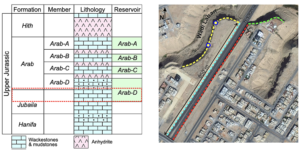Geometry, spatial arrangement and origin of carbonate grain‐dominated, scour‐fill and event‐bed deposits: Late Jurassic Jubaila Formation and Arab‐D Member, Saudi Arabia
Outcrop analogues of the Late Jurassic lower Arab‐D reservoir zone in Saudi Arabia expose a succession of fining‐upward cycles deposited on a distal middle‐ramp to outer‐ramp setting. These cycles are interrupted by erosional scours that incise up to 1·8 m into underlying deposits and are infilled with intraclasts up to boulder size (1 m diameter). Scours of similar size and infill are not commonly observed on low‐angle carbonate ramps. Outcrops have been used to characterize and quantify facies‐body geometries and spatial relationships. The coarse grain size of scour‐fills indicates scouring and boulder transport by debris or hyperconcentrated density flows strengthened by offshore‐directed currents. Longitudinal and lateral flow transformation is invoked to produce the ‘pit and wing’ geometry of the scours. Scour pits and wings erode up to 1·8 m and 0·7 m deep, respectively, and are on average 50 m wide …

